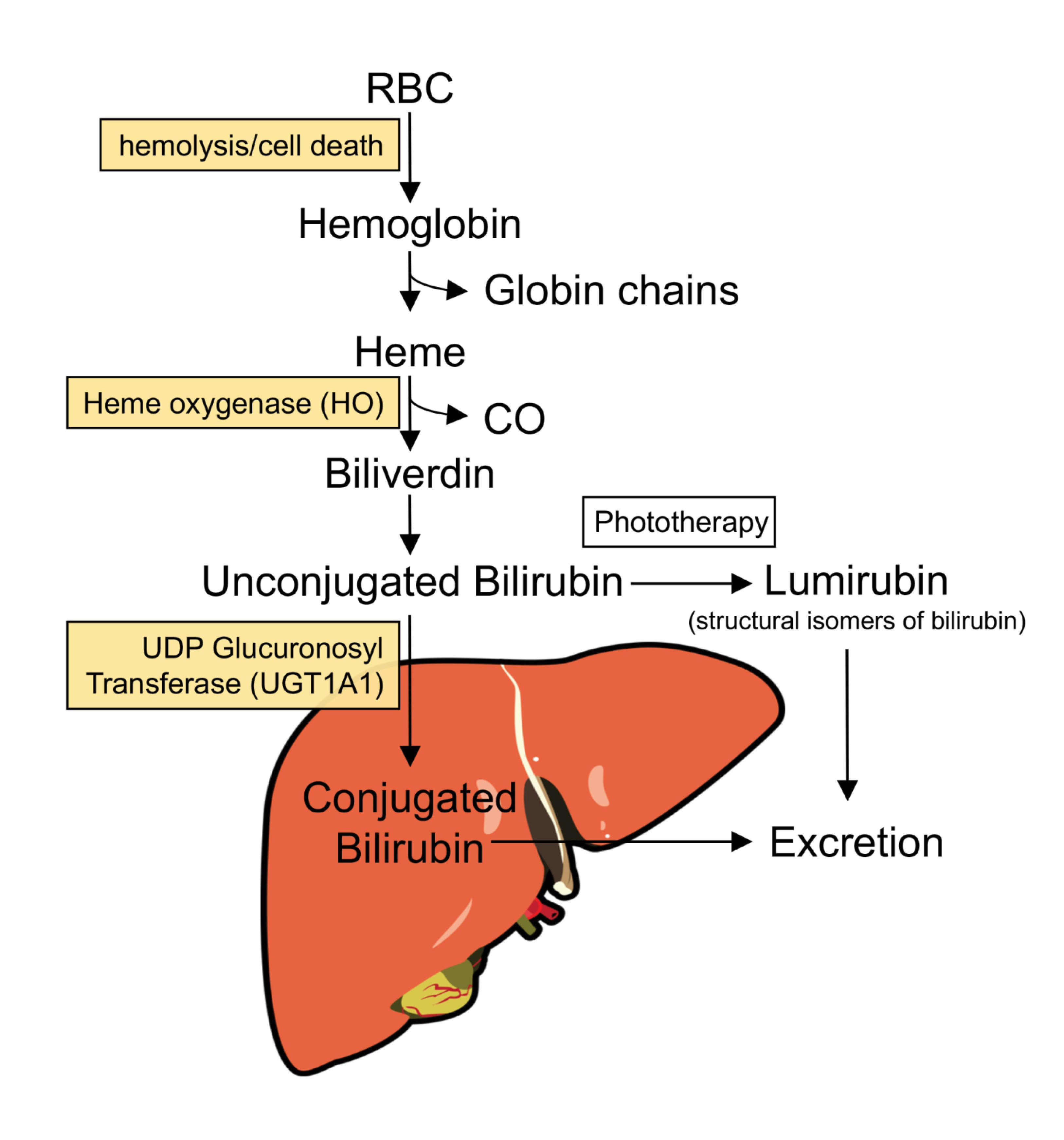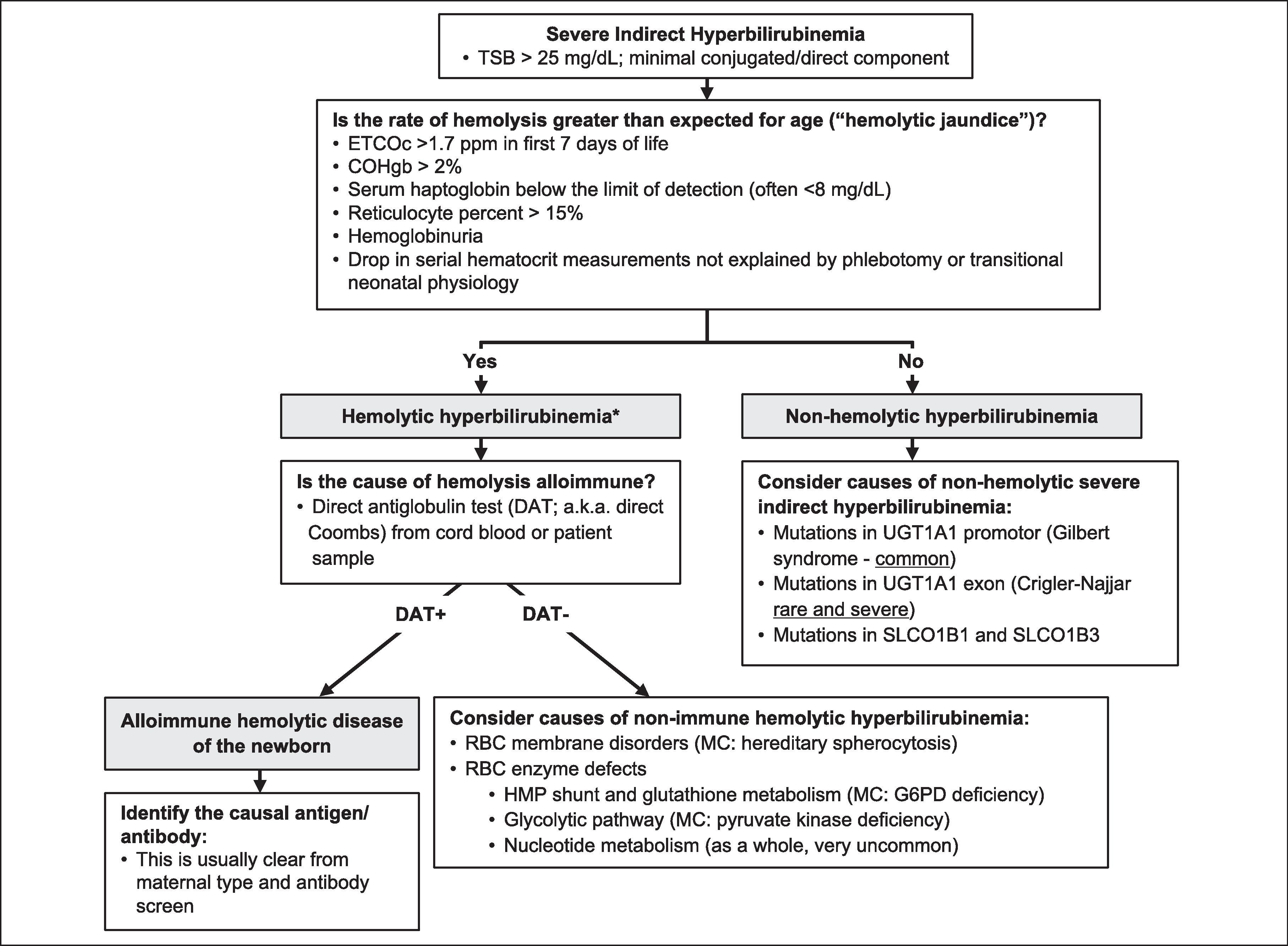Physical Address
304 North Cardinal St.
Dorchester Center, MA 02124
We still need a universally accepted definition of severe hyperbilirubinemia; no particular thresholds of unconjugated or total bilirubin levels have been definitively associated with acute or chronic bilirubin encephalopathy.
Several measurements can be useful for the assessment of hemolysis, such as those of end-tidal carbon monoxide, blood levels of analytes such as carboxyhemoglobin and haptoglobin, reticulocyte percent and number, cell-free hemoglobin, and hemoglobinuria.
Hemolytic causes of hyperbilirubinemia include alloimmune hemolytic diseases. Nonimmune negative hemolytic disease can arise in red blood cell (RBC) enzymopathies, RBC membrane disorders, and globin disorders.
Phototherapy is the standard of care for all cases of hyperbilirubinemia. In severe hyperbilirubinemia, exchange transfusion may also be indicated. Efforts are ongoing to evaluate whether intravenous immunoglobins, metalloporphyrins, and phenobarbital might be useful in specific conditions.
There is no universal definition of severe hyperbilirubinemia because no threshold of laboratory values has been definitively associated with acute or chronic bilirubin encephalopathy. Some groups have suggested that the unconjugated fraction of bilirubin alone can cross the blood-brain barrier and cause bilirubin encephalopathy, and therefore only the unconjugated bilirubin fraction should be considered when evaluating a neonate for treatment of hyperbilirubinemia. Others have suggested that it is the unconjugated bilirubin, not bound to plasma proteins (e.g., albumin), that is more robustly associated with bilirubin encephalopathy. , Because none of these hypotheses have been upheld with uncontroversial evidence, we utilize the total serum bilirubin measurement in our evaluation of neonatal hyperbilirubinemia.
Understanding the evaluation and treatment of severe neonatal indirect hyperbilirubinemia is simplified by understanding the fundamental steps in heme metabolism and bilirubin conjugation and excretion ( Fig. 42.1 ). These crucial steps include (1) red blood cell (RBC) lysis or death, (2) the conversion of heme into biliverdin by heme oxygenase, and (3) the intrahepatic conjugation or glucuronidation of bilirubin by uridine diphosphate (UDP) glucuronosyl transferase (UGT1A1). In the most simple terms, hyperbilirubinemia is the result of either (1) excessive bilirubin production, (2) decreased bilirubin metabolism or elimination, or (3) a combination of the two. Aberrations in these crucial steps result in any of these broad etiologies.

This chapter will explore both well-established and innovative approaches to the evaluation and treatment of severe hyperbilirubinemia. Ultimately, the goal of evaluation and treatment of severe hyperbilirubinemia is to prevent bilirubin-induced neurologic dysfunction.
Determining the cause of severe indirect hyperbilirubinemia can have implications on immediate and long-term management of infants. Historically, our ability to identify the cause of severe hyperbilirubinemia has been poor. In the US voluntary Kernicterus Registry, conducted in the 1990s by Drs. Bhutani and Johnson, no clear explanation for the hyperbilirubinemia was identified in 55% of the 125 patients in the registry. Christensen et al. reported similar findings retrospectively in the Intermountain Healthcare system in the Western United States, where among 302,399 live births, 32 neonates had a total serum bilirubin >30 mg/dL. Of these 32, only 11 (65.6%) had an explanation found for their extreme hyperbilirubinemia and the remaining patients were listed as having “idiopathic” jaundice.
Subsequently, in a pilot registry in the state of Utah, Christensen successfully identified the cause of hyperbilirubinemia in all cases of acute bilirubin encephalopathy between 2009 and 2018 (seven cases). Two cases were caused by immune-mediated hemolysis. The remaining five had genetic mutations causing increased bilirubin production through hemolytic mechanisms. Two of these five patients also had a genetic mutation retarding bilirubin conjugation (Gilbert syndrome). This study, although small, illustrated the growing availability and value of genetic sequencing in seeking the diagnosis of Coombs-negative hemolytic jaundice (and even nonhemolytic jaundice). At least two laboratories in the United States offer next-generation sequencing panels designed to diagnose genetic causes of severe hyperbilirubinemia: ARUP Laboratories (Salt Lake City, Utah) and Mayo Clinic Laboratories (Rochester, Minnesota). Although these panels are labeled “hereditary hemolytic anemia” panels, they both also include genes involved in bilirubin transport, conjugation, and excretion. Due to cost, we reserve these panels for more severe cases when a narrower differential diagnosis does not lead us to a more directed approach to diagnosis.
Our general approach to evaluating severe hyperbilirubinemia is to first determine whether hemolysis (increased bilirubin production) is a contributing factor, keeping in mind that the presence of hemolysis does not exclude coinheritance of mutations that slow bilirubin elimination. In fact, it is our experience that cases where increased bilirubin production and retarded bilirubin elimination are both present result in the most severe hyperbilirubinemia. Determining whether the rate of bilirubin production is significantly increased will then help refine the differential diagnosis and guide the approach to the patient ( Fig. 42.2 ). Here, we will first discuss tools used to differentiate hemolytic from nonhemolytic jaundice. Then we will discuss the most common hemolytic and nonhemolytic causes of severe hyperbilirubinemia.

Elevated carbon monoxide levels in neonates with erythroblastosis fetalis was first described in the 1971 by Jeffrey Maisels in the laboratory of David Nathan. Carbon monoxide (CO) is generated in equimolar amounts to bilirubin as heme is metabolized to bilirubin. Thus ETCOc (end-tidal carbon monoxide [CO] “corrected,” which is end-tidal CO minus ambient CO) in exhaled breath can be used to quantify the hemolytic rate. For many years, measurements of CO in the blood were only available by gas chromatography, and devices to measure CO in the breath did not exist. Portable devices are now available to obtain an accurate measurement of the ETCO noninvasively, at the patient’s bedside, in less than 2 to 3 minutes. A wealth of literature supports the use of ETCOc measurement devices to quantify the rate of hemolysis in a patient and therefore identify patients with hyperbilirubinemia for whom increased hemolysis is a contributing factor. Of the techniques described here, we consider ETCOc determinations to be the most helpful because they are sensitive and accurate, require little time, and require no phlebotomy. Based on a publication by Christensen et al. in 2015, we consider an ETCOc measurement >1.7 ppm in a term newborn in the first week of life to be consistent with hemolysis. Beyond 1 week, ETCOc determinations >1.0 ppm should raise concern for hemolysis.
Carboxyhemoglobin levels can be measured directly in the blood and have utility to detect increased hemolysis similar to the ETCOc measurement. Carboxyhemoglobin values are often obtained from a blood gas by cooximetry and are reported as a percentage of hemoglobin “saturated” with CO. The upper limit in the newborn has been reported between 1.5% and 2.0%. Although this measure is not sensitive, it seems to be specific when elevated above 2.0%.
Haptoglobin is a protein synthesized by the liver that is used to scavenge and recycle free hemoglobin. Once plasma hemoglobin is bound to haptoglobin in a haptoglobin-hemoglobin complex, it is rapidly cleared from the circulation. Therefore depletion of serum haptoglobin can be a sign of excess cell-free hemoglobin resulting from hemolysis. However, haptoglobin levels are normally lower in the newborn than in a child or adult. Therefore the validity of the serum haptoglobin concentration as a marker of hemolysis is variable. We judge that in a neonate, a serum haptoglobin level that is falling or is below the lower limit of detection is consistent with hemolysis.
Reticulocytosis is the physiologic response to hypoxia due to anemia. At the time of delivery, the newborn is exposed to a relative hyperoxic environment that suppresses erythropoietin production and results in a decrease in red cell production and decreased reticulocyte production. Therefore the reference interval for reticulocyte percentage or number in the newborn is highly dependent on postnatal age. Because anemia may not be a result of ongoing RBC destruction, reticulocytosis is not specific for hemolysis. A reticulocyte percentage >15% can support the diagnosis of hemolysis but could also arise several days after severe hemorrhage. The immature reticulocyte fraction, reported as a percentage, is an automated reticulocyte parameter that quantifies the proportion of reticulocytes that have a particularly high RNA fraction by flow cytometry. It provides an early and sensitive index of marrow erythropoietic activity and therefore may be even more sensitive than standard reticulocyte measurements. Immature reticulocyte fraction values greater than 7% at birth or >3% after 24 hours of life are consistent with a diagnosis of hemolysis.
Cell-free hemoglobin should be uncommon in the healthy newborn. Therefore, trace hemoglobinuria or greater is evidence of hemolysis.
Become a Clinical Tree membership for Full access and enjoy Unlimited articles
If you are a member. Log in here